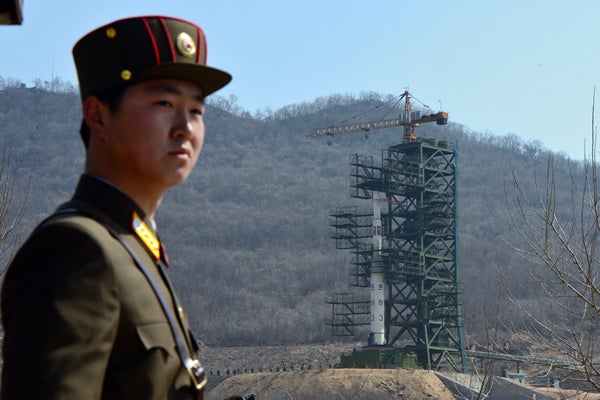North Korea unveiled a new missile during its April parade celebrating the 100th anniversary of the country’s founder, Kim Il-sung. The missile is assessed to be a new mobile intercontinental ballistic missile (ICBM).
Last year, then-Secretary of Defense Robert Gates first revealed the existence of a North Korean road-mobile ICBM. Since the parade, military analysts have disagreed over whether the transporter-erector-launcher vehicles were provided by China and therefore a violation of U.N. resolutions, whether China also provided missile technology to North Korea, and whether the displayed missiles were fakes.
The eight-axle transporter vehicles appear to be based on a Chinese heavy-duty truck chassis built by the Hubei Sanjiang Space Wanshan Special Vehicle Company, a wholly owned subsidiary of the state-owned defense firm China Aerospace Science and Industry Corporation.
U.N. Resolutions 1874 and 1718 require all U.N. member states to prevent the direct or indirect supply or transfer to North Korea—including by their nationals or from their territories—of prohibited items such as “vehicles designed or modified for the transport, handling, control, activation, and launching” of missile systems.
It is unclear, however, whether the Chinese manufacturer or the Chinese government knew that the vehicles were being sold to North Korea to assist in the missile program. The vehicles are dual use (military/civilian) trucks and could have been sold to a North Korean front company or third party that, in turn, sold them to North Korea. The U.S. has asked China for details of the manufacture and export of the trucks.
Some have postulated that China provided assistance on the missile itself. Although Pyongyang may have acquired Chinese technology through third-party sources, there is no evidence that Beijing directly provided or intended to have provided through other sources actual missile technology. Missile experts and a U.S. government report disclosed by Wikileaks agree that North Korea’s indigenous missile program is based on extrapolated technology of Russian Scud and SS-N-6 missiles. The only direct Chinese involvement in a North Korean missile was the DF-61, an incomplete program halted by Beijing in the 1970s.
On the issue of whether the missiles were real or fake, German scientists Markus Schiller and Robert Schmucker commented that there were observable differences amongst the six paraded missiles, which all displayed sloppy workmanship. They concluded that the missiles were fake and that “the whole presentation was staged just for show, to celebrate Kim Il Sung’s 100th birthday.”
Other experts disagree, concluding they were mockups or “missile simulators” of a missile program still in development. The latter group believes it would be incorrect to presume that North Korea does not have a mobile ICBM program in progress, noting that similar assertions were made about the Musudan missiles displayed in the October 2010 parade; that missile has been known to have been deployed.
While Washington should press Beijing for details to determine if the Chinese truck manufacturer violated U.N. resolutions, more importantly, the U.S. should insist that the U.N. target secondary (i.e., foreign) violators. U.N. member nations should fully implement existing U.N. resolution requirements to prevent North Korea’s procurement and export of missile-related and WMD-related items and technology by freezing the financial assets of any involved North Korean or foreign person, company, or government entity. To date, U.N. and U.S. efforts have focused on North Korean entities.
Since China will continue to impede sufficient U.N. action, Washington should independently impose U.S. sanctions on any company or government agency complicit in North Korean proliferation. Washington should then call on other nations to similarly target North Korean and foreign proliferators, as well as those engaged in North Korean illegal activities, such as currency counterfeiting and drug smuggling.
The recent failure of North Korea’s Taepo Dong-2 missile launch has led some to dismiss Pyongyang’s missile threat. That is a mistake. North Korea has successfully flown its Scud and No Dong missiles, of which approximately 700 and 300, respectively, have been deployed. Pyongyang has also developed and deployed (and possibly flight-tested in Iran) Musudan intermediate-range ballistic missiles. It continues to work on its Taepo Dong-2 ICBM, which the U.S. intelligence community assesses could threaten the U.S. with a nuclear warhead by 2015.
In light of this growing missile threat, the U.S. should continue to develop and deploy missile defenses and reverse planned budget cuts. Washington should also call on South Korea to deploy a multilayered missile defense system that is interoperable with a U.S. regional missile network in order to provide for a more coherent and effective defense of allied military facilities and the South Korean populace.



























